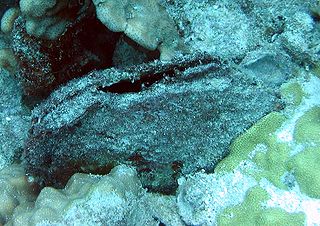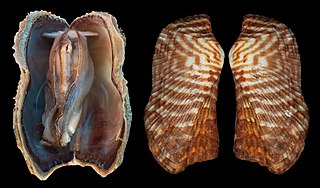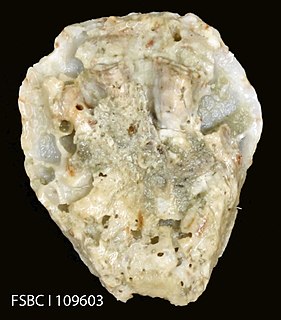
Bivalvia, in previous centuries referred to as the Lamellibranchiata and Pelecypoda, is a class of marine and freshwater molluscs that have laterally compressed bodies enclosed by a shell consisting of two hinged parts. Bivalves as a group have no head and they lack some usual molluscan organs like the radula and the odontophore. They include the clams, oysters, cockles, mussels, scallops, and numerous other families that live in saltwater, as well as a number of families that live in freshwater. The majority are filter feeders. The gills have evolved into ctenidia, specialised organs for feeding and breathing. Most bivalves bury themselves in sediment where they are relatively safe from predation. Others lie on the sea floor or attach themselves to rocks or other hard surfaces. Some bivalves, such as the scallops and file shells, can swim. The shipworms bore into wood, clay, or stone and live inside these substances.

Pinctada is a genus of saltwater oysters, marine bivalve mollusks in the family Pteriidae, the pearl oysters. These oysters have a strong inner shell layer composed of nacre, also known as "mother of pearl".

Pteriidae, also called the feather oysters, is a family of medium-sized to large saltwater clams. They are pearl oysters, marine bivalve molluscs in the order Pteriida.

Melongena is a genus of sea snails, marine gastropod mollusks in the family Melongenidae, the crown conches and their allies.

Stramonita haemastoma, common name the red-mouthed rock shell or the Florida dog winkle, is a species of predatory sea snail, a marine gastropod mollusc in the family Muricidae, the rock snails.

Arca zebra, or the turkey wing ark clam, is a bivalve mollusc in the family Arcidae, the ark clams.
Amygdalum papyrium, common name the Atlantic paper mussel, is a species of marine bivalve mollusc in the family Mytilidae, the true mussels. This species occurs along the Atlantic coast of North America, from Maryland to Florida, as well as in the Gulf of Mexico, from Texas to Mexico.

Isognomon alatus, the flat tree oyster, is a species of bivalve mollusc in the family Isognomonidae. It can be found along the Atlantic coast of North America, ranging from southern Florida to Brazil and Bermuda.

Isognomon radiatus, the radial purse oyster or Lister's tree oyster, is a species of bivalve mollusc in the family Pteriidae. It can be found along the Atlantic coast of North America, ranging from southern Florida to Brazil and Bermuda.

Pteria is a genus of molluscs in the family Pteriidae. The species of the genus are sometimes referred to as wing-oysters or winged oysters.

Pinna carnea, commonly called the amber pen shell, is a species of bivalve mollusc in the family Pinnidae.

Spondylus americanus, the Atlantic thorny oyster, is a species of bivalve mollusc. It can be found along the Atlantic coast of North America, ranging from North Carolina to Brazil.

Anodontia alba, or the buttercup lucine, is a species of bivalve mollusc in the family Lucinidae. It can be found along the Atlantic coast of North America, its range extending from North Carolina in the United States to the West Indies.

Ostrea equestris, commonly known as the crested oyster or horse oyster, is a species of bivalve mollusc in the family Ostreidae. It can be found along the Atlantic coast of North and South America, ranging from Virginia to Patagonia.

Pteria sterna, commonly known as the rainbow-lipped pearl oyster or the Pacific wing-oyster, is a species of marine bivalve mollusk in the family Pteriidae, the pearl oysters. This oyster can be found in shallow water along the tropical and subtropical Pacific coast of America, its range including Baja California, Mexico and northern Peru.

Pinctada mazatlanica is a species of tropical marine bivalve mollusc in the family Pteriidae, the pearl oysters. It is known by the English common names pearl oyster, Mazatlan pearl oyster, and Panama pearl oyster. Spanish common names include madre perla, and ostra perlifera panameña. This mollusc was first described to science in 1856 by conchologist Sylvannus Charles Thorp Hanley. Pinctada mazatlanica produces gem-quality pearls and was the basis of a pearling industry in the Gulf of California for centuries.
Pinctada fucata, the Akoya pearl oyster (阿古屋貝), is a species of marine bivalve mollusc in the family Pteriidae, the pearl oysters. Some authorities classify this oyster as Pinctada imbricata fucata. It is native to shallow waters in the Indo-Pacific region and is used in the culture of pearls.

Pteria penguin, commonly known as the penguin's wing oyster, is a species of marine bivalve mollusc in the family Pteriidae, the pearl oysters. It is native to the western and central Indo-Pacific region and is used for the production of cultured pearls. The generic name comes from Greek πτερον (pteron) meaning wing.

Pinctada margaritifera, commonly known as the black-lip pearl oyster, is a species of pearl oyster, a saltwater mollusk, a marine bivalve mollusk in the family Pteriidae. This species is common in the Indo-Pacific within tropical coral reefs.
Pinctada longisquamosa, sometimes called scaly pearl osters, are a small species of pearl oyster found in the western Atlantic. They are distinguished by unique prismatic shell structures which protrude from the outer shell.



















